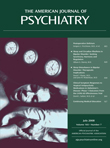Addictive Potential of Quetiapine
To the Editor: The feigning of symptoms in order to gain access to addictive substances is a veritable cliché in urgent care settings. However, malingering psychotic symptoms in order to secure antipsychotic medication is unusual and counterintuitive. The preclinical sine qua non of antipsychotic efficacy has been the ability of a compound to ablate or at least attenuate reward learning in animal models. These compounds are notoriously “dysphorogenic,” devoid of abuse potential, and subjectively noxious to the degree that medication adherence is one of the preeminent challenges of treatment. The newer “atypical” antipsychotic compounds have generally improved on this subjective intolerability, which has led to the steadily expanding use of these compounds in nonpsychotic patient populations, targeting extrapsychotic symptom clusters such as anxiety, mood variability, and even pedestrian insomnia. We present a case report of an individual who demonstrated classic drug seeking behavior, compulsive drug use, and diversion for resale of the atypical antipsychotic compound quetiapine.
“Mr. A” was a 29-year-old divorced, unemployed, Caucasian man, with an unclear medical history, who presented himself as a walk-in to our acute psychiatric treatment unit with a medication refill request. He reported that he had been diagnosed with schizophrenia (for which he was being treated with quetiapine [600 mg nightly]) and the local police were disturbing his sleep by “electronically monitoring” his testicles. He received his “usual” dose of quetiapine and then slept soundly. On examination the following morning, Mr. A had become cagey about the details of his somatic preoccupation and, although still somnolent, he lacked evidence for either a thought or mood disturbance. His urine toxicology screen was negative. The profundity of his sedation prompted a pharmacy review, which revealed that he had been receiving different and excessive amounts of quetiapine from several sources during the past few months. Upon confrontation, he admitted to both the excessive use and sale ($3.00 per 100 mg tablet) of quetiapine.
Quetiapine has come to dominate the atypical antipsychotic market, primarily through its use in the technically “off label” circumstances described previously. The modestly sedating toxic profile and perceived absence of abuse liability of the drug have prompted many clinicians to use it in place of traditional benzodiazepines for anxiety and insomnia. There is currently an accumulating body of anecdotal evidence (1 – 3) regarding the type of patient described in our case report, which questions both the accuracy of perceptions about the use of quetiapine and the wisdom of treatment practices. If the current misuse of the compound continues or expands, then the abuse “signal” will predictably become more evident and could ultimately prompt federal regulators to declare quetiapine a controlled substance. Should such an unfortunate eventuality come to pass, we will be able to confidently lay the blame at the feet of our collective prescriptive imprudence.
1. Pierre JM, Shnayder I, Wirshing DA, Wirshing WC: Intranasal quetiapine abuse (letter). Am J Psychiatry 2004; 161:1718Google Scholar
2. Hussain MZ, Waheed W, Hussain S: Intravenous quetiapine abuse (letter). Am J Psychiatry 2005; 162:1755–1756Google Scholar
3. Pinta ER, Taylor RE: Quetiapine addiction? (letter) Am J Psychiatry 2007; 164:174–175Google Scholar



